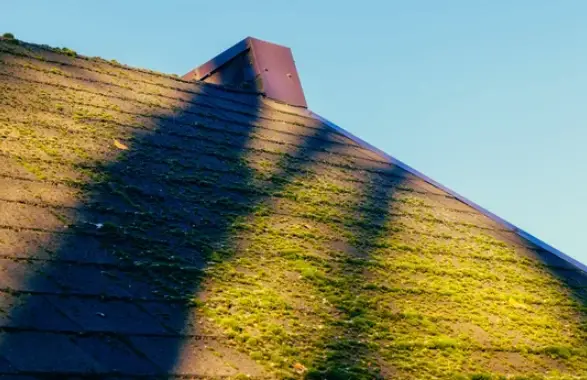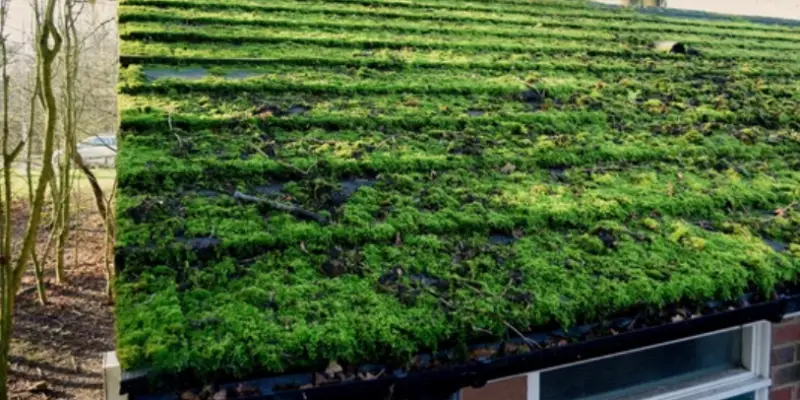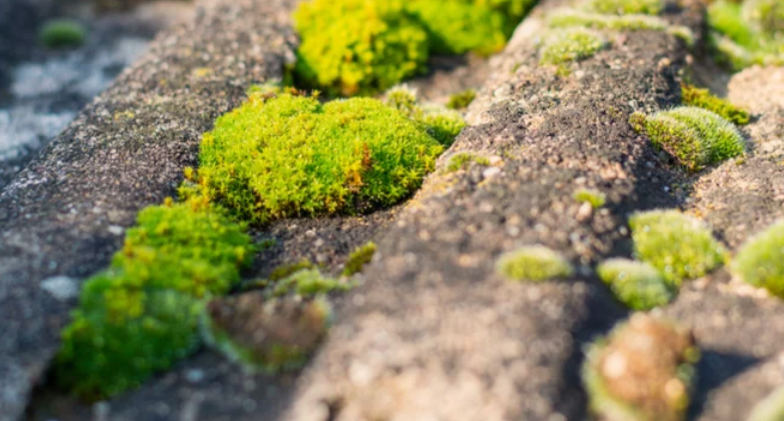Moss on roofs may seem like an innocent plant growth, but it can actually cause significant damage if not properly addressed.
In this blog post, we will explore what causes moss to grow on roofs and the potential consequences it can have on your home.
We will also discuss preventive measures and effective methods to remove moss from your roof.
What is Moss Growth on Roofs?

Moss is a small, non-vascular plant that thrives in damp environments.
It reproduces through spores and can easily take hold on various surfaces, including roofs.
While it may initially seem harmless, moss can cause several problems when it grows on your roof.
Understanding the causes of moss growth is crucial to prevent potential damage.
Causes of Moss Growth on Roofs
Moss growth on roofs is primarily caused by a combination of factors, including:
Moisture
Excessive moisture is the primary catalyst for moss growth.
Roofs that receive limited sunlight and are prone to retaining moisture, such as those shaded by trees or facing north, create favorable conditions for moss to flourish.
Shade
Moss prefers shaded areas since direct sunlight inhibits its growth.
Therefore, buildings surrounded by trees or in areas with high levels of shade are more likely to experience moss growth on their roofs.
Poor drainage
Roofs with inadequate drainage systems can retain water for extended periods, creating a perfect breeding ground for moss.
Clogged gutters, improper slopes, or damaged roofing materials can contribute to poor drainage.
Organic debris
Organic matter, such as leaves, twigs, and other debris accumulating on the roof, can provide nutrients for moss growth.
If not removed regularly, this debris can create a hospitable environment for moss to take hold.
Consequences of Moss Growth on Roofs

Allowing moss to flourish on your roof can lead to several potential consequences, including:
Roof damage
Moss can compromise the integrity of your roof. Its root-like structures can penetrate and lift roofing materials, loosen shingles, and create gaps where water can accumulate.
Over time, this can lead to leaks and significant structural damage.
Reduced lifespan
Moss growth accelerates the aging process of roofing materials.
Its ability to retain moisture can degrade shingles and other roofing components, reducing their durability and lifespan.
Increased energy costs
Moss can also impact your home’s energy efficiency.
Its presence on the roof can obstruct the flow of water off the surface, leading to water pooling.
This trapped water can seep into the attic, causing insulation damage and potentially increasing heating and cooling costs.
Aesthetics
While not directly impacting your roof’s functionality, moss growth can significantly impact the visual appeal of your home.
Thick mats of moss can make your roof appear dirty, unkempt, and aged, affecting the overall curb appeal and potentially reducing property value.
Preventive Measures to Control Moss Growth
Taking proactive steps to prevent moss growth on your roof is key to avoiding potential damage.
Here are some preventive measures you can implement:
Sunlight exposure
Ensure that your roof receives adequate sunlight by trimming tree branches near the roofline.
This will help inhibit moss growth by reducing shade and promoting faster drying of the roof surface.
Regular roof maintenance
Regularly inspect your roof for any signs of moss growth or debris accumulation.
Keep gutters clean to ensure proper water flow and prevent water retention.
Zinc or copper strips
Install zinc or copper strips along the ridge of your roof.
When it rains, these metals release ions that deter moss growth.
However, proper installation is crucial for maximum effectiveness.
Chemical treatments
Moss-killing treatments, such as zinc sulfate or potassium salts, can be applied to prevent moss growth.
However, caution must be exercised when using chemicals, as certain mixtures can damage roof materials or harm surrounding vegetation.
Effective Moss Removal Methods
Physical removal: Gently scrape moss off the roof using a soft brush or plastic scraper. Ensure that you do not damage or dislodge roofing material. This method is best suited for minor moss infestations.
Pressure washing: For more severe cases, pressure washing can effectively remove moss.
However, caution must be exercised to avoid damaging the roof surface.
Use low-pressure settings and maintain a safe distance from the roof to prevent shingle dislodgment.
Chemical treatments: Moss-killing chemicals can be effective in removing moss.
Apply the appropriate chemical solution as per the manufacturer’s instructions.
Be mindful of using environmentally-friendly options and take precautions to protect surrounding vegetation.
Professional services: If the moss growth is extensive or you are not comfortable performing the removal yourself, consider hiring professional roofing or moss removal services.
They have the expertise and equipment necessary to safely and effectively remove the moss while minimizing the risk of damage to your roof.
Environmental Impact of Moss Growth
Water runoff: Moss can affect the quality of water runoff from your roof.
When it rains, the moss absorbs water and releases it slowly, leading to increased runoff times.
This can overwhelm gutter systems and potentially cause localized flooding.
It is important to address moss growth to maintain the proper functioning of drainage systems.
Biodiversity: Moss provides a habitat for a variety of organisms, such as insects, spiders, and small animals.
While this may seem beneficial, an overgrowth of moss can crowd out other plant species and disrupt the biodiversity of your roof ecosystem.
Promoting a balanced roof ecosystem is important for overall environmental health.
Air quality: Moss can capture and retain microscopic airborne particles, including pollutants and allergens.
This can have a positive effect on local air quality, particularly in urban areas with higher pollution levels.
However, excessive moss growth can also trap moisture, creating a damp environment that promotes the growth of mold and other microorganisms that can negatively impact air quality.
Importance of Professional Roof Inspections
Regular roof inspections by a professional can help identify and address moss growth in its early stages.
Here are a few reasons why professional roof inspections are essential:
Expertise: Professional roof inspectors have the knowledge and experience to detect signs of moss growth, even in hard-to-reach areas.
They can assess the extent of the problem and recommend appropriate solutions.
Safety: Climbing onto a roof to inspect and remove moss can be dangerous, especially for individuals without the proper training and equipment.
Professional roofers have safety protocols in place to ensure their own safety and the integrity of your roof.
Comprehensive assessment: During a roof inspection, professionals can identify other potential issues that may be contributing to moss growth.
This can include damaged flashing, inadequate ventilation, or gutter problems.
Addressing these underlying issues can help prevent future moss growth.
Warranty protection: If your roof is under warranty, regular professional inspections may be required to maintain the warranty coverage.
Failure to follow these requirements may lead to the invalidation of your warranty, potentially leaving you responsible for any repair or replacement costs.
Conclusion
Moss growth on roofs can pose significant problems if left untreated.
Understanding the causes of moss growth and taking preventive measures is crucial to maintain the integrity and longevity of your roof.
Regular maintenance, including keeping the roof clean and promoting sunlight exposure, can help minimize moss growth.
If moss is already present, employ appropriate removal techniques or seek professional assistance.
If you address moss growth promptly, you can ensure a healthier, more attractive roof while avoiding potential damage and costly repairs.




